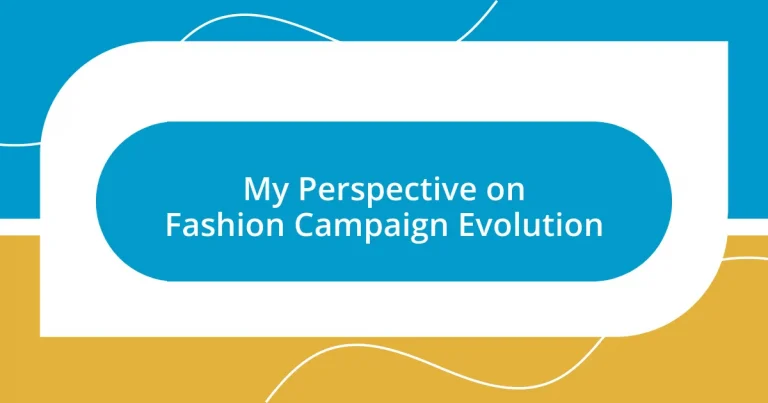Key takeaways:
- Fashion campaigns have evolved from simple advertisements to intricate narratives that reflect cultural and societal shifts, emphasizing individuality and self-expression.
- The rise of digital media and social platforms has transformed consumer-brand interactions, fostering real-time engagement and community-building through innovative storytelling and user-generated content.
- Contemporary campaigns prioritize diversity, sustainability, and social justice, aligning with consumer values and creating deeper connections through inclusivity and authenticity.
- Future trends in fashion campaigns are likely to focus on sustainability, augmented reality experiences, and hyper-personalized marketing to enhance consumer engagement.
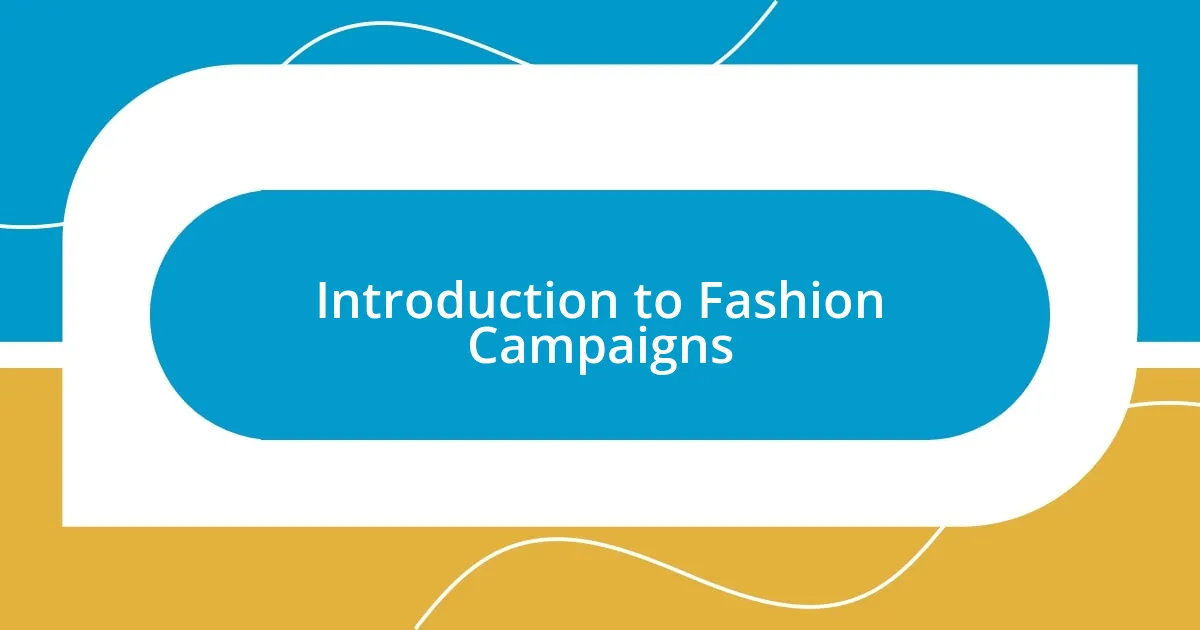
Introduction to Fashion Campaigns
Fashion campaigns have long served as a mirror to society, reflecting not only trends but also cultural shifts. I remember the excitement of seeing a new campaign launch, thinking, “What stories do these images tell?” There’s something powerful about how a single campaign can evoke emotions and set the stage for what we wear and why.
When I think back to my favorite fashion campaigns, I realize they were more than just advertisements; they were narratives that shaped consumer identities. For instance, the bold choices and striking visuals from a certain iconic campaign sparked a realization for me that fashion is a dialogue—a way to express our individuality and connect with others. Isn’t it fascinating how a few carefully crafted images can influence our thoughts on style and self-expression?
In today’s fast-paced world, the evolution of fashion campaigns is undeniable. With digital platforms dominating the landscape, I often wonder how brands adapt their storytelling to engage consumers in this new ecosystem. What once was a print ad now transforms into interactive experiences that invite us into the fashion narrative, making us feel like active participants rather than mere observers.

Historical Overview of Fashion Campaigns
Reflecting on the historical timeline of fashion campaigns, I notice a significant shift from simple print ads in the early 20th century to more intricate storytelling in later decades. I recall coming across vintage magazine clippings showing elegantly posed models, conveying a sense of luxury and aspiration. It’s interesting how these campaigns, often featuring aristocratic imagery, were intended to project an ideal lifestyle that many could only dream of—this was the aspiration era, and fashion was its vessel.
As the decades rolled on, major shifts happened, particularly in the 1960s and 1980s, when concepts of counterculture and individual expression began to permeate the fashion industry. I remember flipping through popular fashion magazines from that time, where vibrant and rebellious visuals captured a youth-driven culture, from punk to disco. These campaigns spoke not just to what we wore, but to who we were becoming as individuals, reflecting societal changes and the desire for self-expression.
In the contemporary era, I see a growing emphasis on diversity and sustainability within fashion campaigns, highlighting varied body types and cultural backgrounds. This evolution resonates with me deeply; as a consumer, it’s refreshing to witness brands producing campaigns that feel inclusive and relatable. It’s not just about selling clothes anymore; it’s about representing a lifestyle and a community that we all want to belong to.
| Era | Characteristics |
|---|---|
| Early 20th Century | Simple print ads, luxury and aspiration |
| 1960s-1980s | Counterculture themes, individual expression |
| Contemporary Era | Diversity and sustainability, community representation |
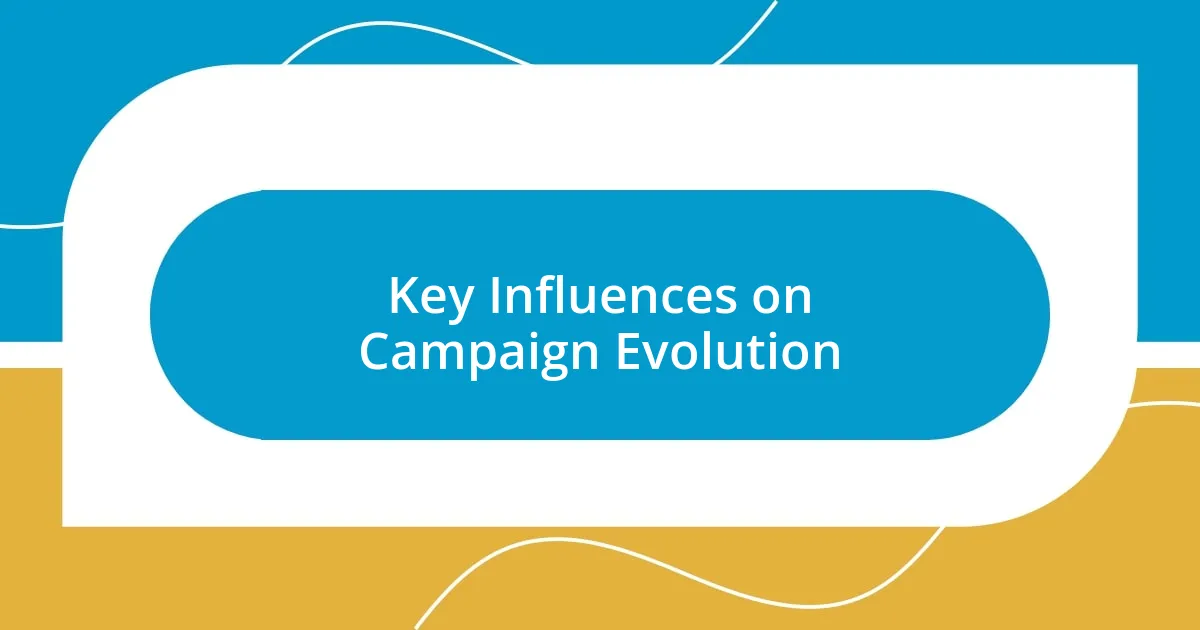
Key Influences on Campaign Evolution
The evolution of fashion campaigns is profoundly influenced by various cultural and technological factors. I often think about how the rise of social media has redefined how brands connect with their audiences. I remember scrolling through Instagram and coming across a vibrant campaign that felt like a conversation rather than a one-way street. It’s incredible how platforms like these have made a direct line between consumers and brands, allowing for real-time feedback and engagement.
Here are some key influences shaping the evolution of fashion campaigns:
- Digital Transformation: The shift from traditional media to online platforms enables interactive storytelling.
- Cultural Shifts: Moments like the #MeToo and Black Lives Matter movements have urged brands to align with social justice and authenticity.
- Influencer Marketing: Collaborating with relatable figures helps brands reach niche markets and fosters a more personal connection with consumers.
- Sustainability: Growing awareness of environmental impact pushes campaigns to highlight eco-friendly practices, resonating with conscientious shoppers.
- Globalization: Exposure to diverse cultures enriches campaign narratives, appealing to a broader audience while promoting inclusivity.
As I reflect on these influences, I can’t help but feel grateful for the transparent nature of modern campaigns. It feels like we’re not just passive viewers; we’re part of a larger narrative that values authenticity and inclusiveness. My favorite campaigns now resonate on a deeper level, encouraging me to think critically about the brands I support and the messages they convey. The stakes have never felt higher, but the possibilities are also more exciting than ever.
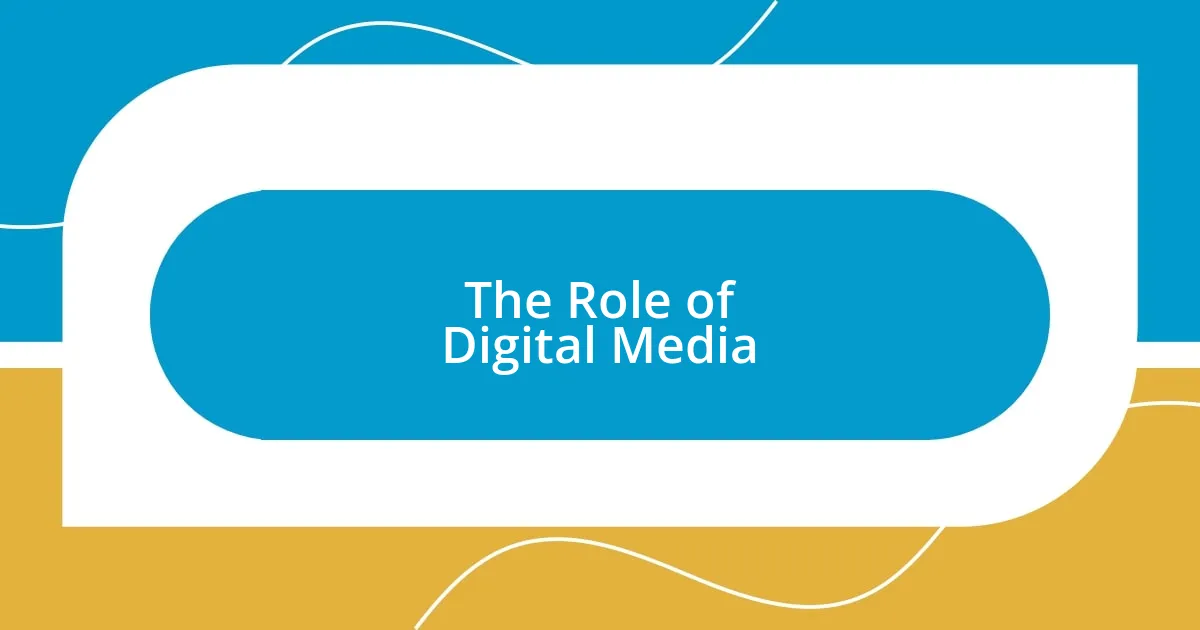
The Role of Digital Media
Digital media has undeniably transformed the landscape of fashion campaigns. I remember the first time I encountered a fashion story told through a series of Instagram posts. Each image, vibrant and meticulously curated, felt like a glimpse into an exclusive world. This kind of storytelling engages us on a more intimate level, allowing us to experience the campaign as if we were part of it, rather than mere spectators.
With the rise of platforms like TikTok, fashion campaigns have become even more interactive. I was fascinated when I stumbled upon a trend where users would recreate iconic looks, breathing new life into past collections. It made me question traditional marketing methods—why settle for a static image when you can create a movement? This shift encourages brands to connect with their audience in more innovative and relatable ways.
Moreover, the accessibility of digital media offers an incredible opportunity for diverse voices in fashion. I recall feeling inspired by a campaign that featured models of all shapes, sizes, and backgrounds sharing authentic stories. Seeing real people rather than just idealized models made me feel more seen and valued. It’s a reminder that fashion is for everyone. In this digital age, isn’t it refreshing to see brands embracing authenticity and creating a community around inclusivity?
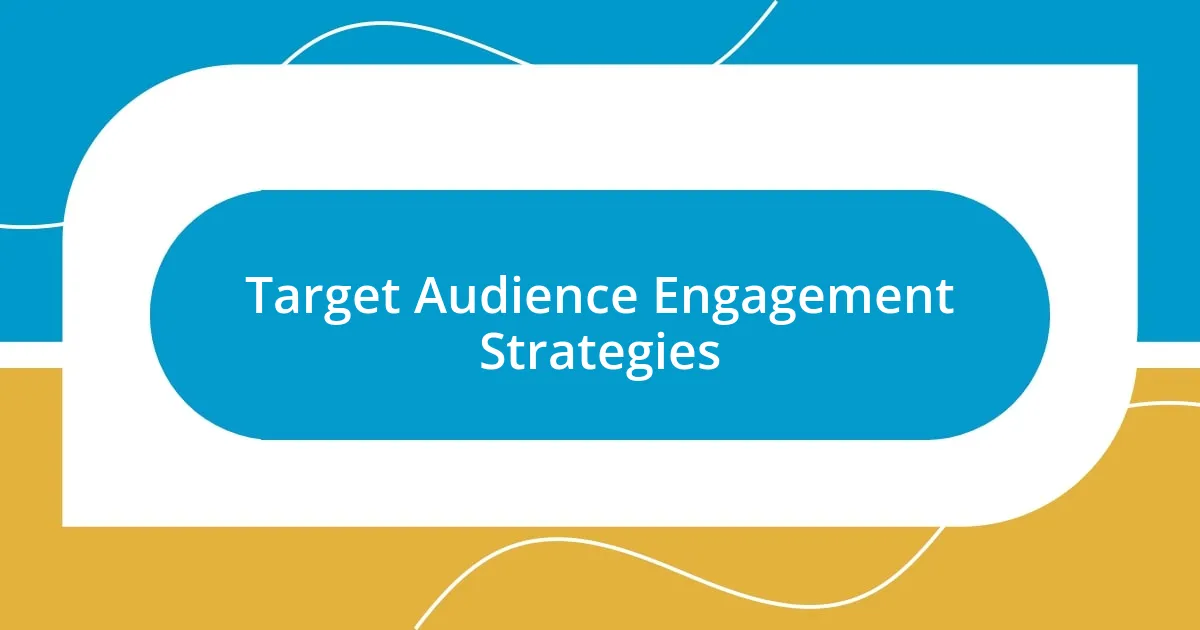
Target Audience Engagement Strategies
Engaging with the target audience has become an art form in the evolving fashion landscape. Think about when I first participated in a brand’s online poll to choose the next collection style. It felt empowering, as if I had a say in the creative process. By actively involving consumers in decision-making, brands not only build loyalty but also create a sense of community that resonates deeply.
Social media challenges illustrate the power of gamification in engagement strategies. I recall joining a challenge where participants styled outfits based on a prompt, sharing their interpretations via hashtags. This experience opened my eyes to the creativity within the audience and how brands could harness that energy to foster interaction. Isn’t it fascinating how a simple call to action can lead to an ocean of creativity?
Moreover, live streaming events have transformed how brands connect with their followers. I remember tuning in to a live fashion show, where I could comment in real-time and ask questions. This unique experience felt like a backstage pass, allowing me to engage directly with the designers and models. It’s moments like these that blur the lines between audience and creator, making fashion feel less like a distant industry and more like a shared passion. How has your interaction with a brand changed your perception of it?

Case Studies of Successful Campaigns
One campaign that stands out to me is the “#MyCalvins” initiative by Calvin Klein. This campaign harnessed the power of user-generated content, inviting fans to share their own stories and photos wearing the iconic brand. I remember scrolling through social media and seeing a friend’s post that captured her confidence in a Calvin Klein outfit, which made me think about how personal expression in fashion can create a deep, relatable connection. Isn’t it remarkable how a campaign can turn everyday consumers into brand ambassadors?
Another great example is Nike’s “Dream Crazy” campaign featuring Colin Kaepernick. When I first saw the powerful imagery and heartrending messages about social justice, I felt a wave of inspiration. It pushed me to consider the role of brands in advocating for important issues. Nike didn’t just sell a product; they sparked conversations, encouraging their audience to dream bigger and stand up for what they believe in. How often do we associate a brand with a cause that resonates with our values in such a profound way?
Lastly, I’ve always admired Dove’s “Real Beauty” campaign, which focuses on body positivity and self-esteem. I vividly recall the first time I encountered their ads that showcased women of all shapes and backgrounds. They had a raw authenticity that challenged conventional beauty standards. Seeing those images stirred a sense of empowerment within me, making me reflect on the importance of representation in fashion. Doesn’t it feel good to see a brand leading a brave conversation that uplifts rather than diminishes?
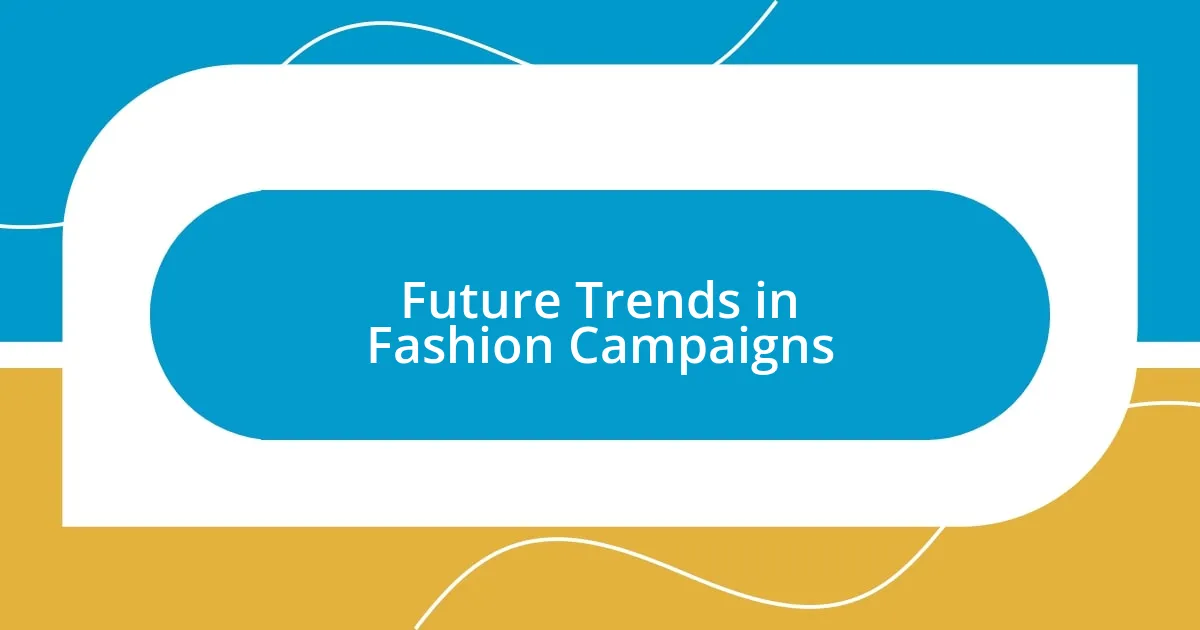
Future Trends in Fashion Campaigns
I believe the future of fashion campaigns will heavily focus on sustainability and ethical practices. As a consumer, I’ve become increasingly aware of the impact my choices have on the environment. I recently switched to brands that openly share their sustainability efforts, and it feels rewarding to support companies that align with my values. Isn’t it inspiring when a brand commits to not just looking good but doing good as well?
Another trend that fascinates me is the integration of augmented reality (AR) in campaigns. I vividly recall trying out a virtual fitting room feature on an app, where I could see how clothes looked on me without stepping foot in a store. It felt almost magical! This tech-savvy approach offers a fun, interactive way for brands to engage shoppers and provide them with a unique shopping experience. How cool is it that technology can bridge the gap between online and in-store shopping?
Moreover, I see a movement towards hyper-personalized marketing strategies in fashion campaigns. I recently discovered a brand that tailored its advertisements based on my browsing habits, showcasing pieces that genuinely intrigued me. It made me feel seen and understood, as though the brand knew my style intimately. Isn’t that the ultimate goal of a campaign—making each consumer feel like the brand is speaking directly to them? This trend will undoubtedly shape campaigns as they strive to connect on a more personal level.












